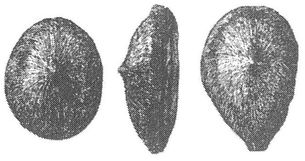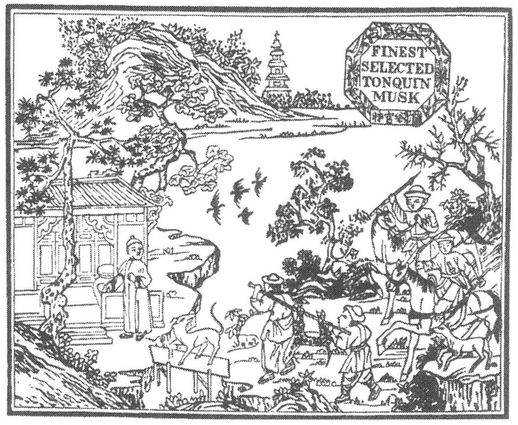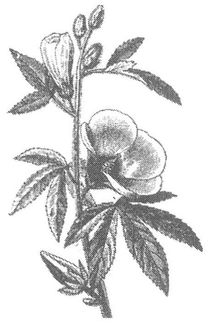Essence and Alchemy (11 page)
Read Essence and Alchemy Online
Authors: Mandy Aftel

Musk pods

The power of musk as an aphrodisiac is legendary as well. The empress Josephine loved it, and her dressing room was filled with it despite Napoléon's frequent remonstrances. Forty years after her death (and repeated washings and coats of paint), the scent persisted. Alas, I have never been able to track down a specimen of true musk to sample. In the past, the dried pods were packed in dainty and elaborate boxes or caddies lined with metal and covered with patterned silk. It was always extremely expensive, and often adulterated. In my antique perfume books from the 1860s, the authors already mention the musk deer's danger of extinction, thanks
to overzealous hunters. (According to Steffen Arctander, it is possible to remove the pouch without killing the animal, but I do not know whether this has ever actually been done.) I have heard that real musk is still used in some of the more costly perfumes, but secrecy prevails.
to overzealous hunters. (According to Steffen Arctander, it is possible to remove the pouch without killing the animal, but I do not know whether this has ever actually been done.) I have heard that real musk is still used in some of the more costly perfumes, but secrecy prevails.
Capture of musk deer, Chinese woodcut

Ambergris
62
is another ingredient upon which legends have been built. It was once classed among the most lucrative items of trade, along with slaves and gold. An early-eighteenth-century writer praised it as “the dearest and most valuable commodity in France” and reported a contemporary in England as having been informed that it was a “mass of honeycombs” that “bees make upon the large rocks, which are the Sea Side in the Indies, which heated by the Sun, loosen and fall into the Sea.” There, “whether by property of the sea water or by the Virtue of the Sunbeams,” they were “rendered liquid and floating upon the water.”
62
is another ingredient upon which legends have been built. It was once classed among the most lucrative items of trade, along with slaves and gold. An early-eighteenth-century writer praised it as “the dearest and most valuable commodity in France” and reported a contemporary in England as having been informed that it was a “mass of honeycombs” that “bees make upon the large rocks, which are the Sea Side in the Indies, which heated by the Sun, loosen and fall into the Sea.” There, “whether by property of the sea water or by the Virtue of the Sunbeams,” they were “rendered liquid and floating upon the water.”
In actuality, ambergris is a peculiar morbid growth that is occasionally produced in the stomach or intestine of the now-endangered male sperm whale. The growth is apparently induced by undigested pieces of cuttlefish, which set up an intense irritation in the whale's stomach. Before the growth gets too large, the whale regurgitates it, and the beneficiaries were the sailors who once encountered it with some regularity off the coasts of Africa, the East Indies, China, Japan, Australia, and New Zealand.
Stories about ambergris finds rival those of the discovery of the Maltese falcon. A report from the 1930s claimed that some Hawaiian cowboys noticed some masses of what they took to be sponge in the ocean and thought to use them to wipe down their ponies. Discovering that the material was not sponge, they took a sample to a local merchant, who identified it as ambergris. They hurried back to the spot where they had found it and managed to salvage enough to make them all financially independent for life.
Like musk, ambergris in its solid state will retain its odor for centuries. And like musk, it is extraordinarily expensive and difficult to find. I have heard that it is still possible to get, but I have never located any, even simply to smell. Reports suggest that the odor is not easy to define. To some it is earthy or musty, to others a curious mixture of seaweed and roses. Many people find it disagreeable, even offensive, but minute quantities dissolved in alcohol are said to give perfume a velvety quality that clings to woven fabrics after they have been repeatedly washed and dried, becoming ever-sweeter over time.
Civet
âwhat Shakespeare called “the very uncleanly flux of a cat”âis the only one of the four animal ingredients (the fourth being castoreum, which comes from the beaver) that is still readily available and used, in slight quantities, in many perfumes. Although the civet is commonly referred to as a cat, it is not a true member of the cat family (
Felidae
) but belongs to the
Viverridae
, which includes the mongoose. It is about the size of a fox, with gray fur and black spots.
It is native to Abyssinia, Java, Borneo, Sumatra, and Bengal. Both males and females have a deep pouch in the posterior part of the abdomen, containing the perineal glands and the soft, fatty substance they produce. Its function is not fully understood, but it is believed to be a sexual attractant and also, perhaps, a means of defense, on account of its foul odorâalthough hounds will leave any other scent to pursue it.
âwhat Shakespeare called “the very uncleanly flux of a cat”âis the only one of the four animal ingredients (the fourth being castoreum, which comes from the beaver) that is still readily available and used, in slight quantities, in many perfumes. Although the civet is commonly referred to as a cat, it is not a true member of the cat family (
Felidae
) but belongs to the
Viverridae
, which includes the mongoose. It is about the size of a fox, with gray fur and black spots.
It is native to Abyssinia, Java, Borneo, Sumatra, and Bengal. Both males and females have a deep pouch in the posterior part of the abdomen, containing the perineal glands and the soft, fatty substance they produce. Its function is not fully understood, but it is believed to be a sexual attractant and also, perhaps, a means of defense, on account of its foul odorâalthough hounds will leave any other scent to pursue it.
English dandies of the seventeenth and eighteenth centuries dangled civet-scented gloves and handkerchiefs as they took snuff and ogled the barmaids in coffeehouses like Man's at St. James and Nando's in Fleet Street. The aroma drove the poet William Cowper from Nando's and inspired him to record his revulsion in verse:
I cannot talk with civet in the room,
A fine puss gentleman thats all perfume;
The sight's enough, no need to smell a beau
Who thrusts his nose into a raree show.
A fine puss gentleman thats all perfume;
The sight's enough, no need to smell a beau
Who thrusts his nose into a raree show.
Civet

I'm not with Cowper. Civet is my favorite perfume ingredient, and what it does to a creation is nothing short of magic. Certainly humans find its odor disgusting at full strength, thanks to the presence of the compound skatole. Yet, as with other essences of animal origin, dilution transforms it into a pleasant and singularly attractive scent. There is no ingredient with which civet does not blend beautifully. It prowls through a blend, transforming each of its elements and giving the whole extraordinary depth. As with all magical things, you need only a minute amount to perform miraclesâa drop for one to two ounces of perfume. (For this reason, it is useful to make a tincture of civet so that you can precisely control the amount you add when you are creating a blend: add ten drops of civet to two ounces of alcohol and let it marry for a month.)
Like the other animal essences, civet has tremendous fixation. In fact, long-ago perfumers “pre-fixed” their alcohol by adding civet or any of the other animal fixatives to their perfume alcohol and letting it rest for a month. The resulting alcohol bore no trace of civet in its fragrance, but the perfumes created with that alcohol were more tenacious.
In Ethiopia, where civets are raised for their perfume ingredient, they are kept in terrible conditions, whereas in other parts of the world, such as Vietnam, they roam freely. They are not killed or injured in the extraction process, but they are placed in long cages in which they cannot turn around, and they are teased and irritated, as the secretion is much greater when the cat is angered. The civet is extracted from the pouch with a spatula. It is pale yellow and semiliquid, but it hardens and darkens upon exposure to air.
With civet no longer in such demand, it should be possible to develop a more humane way of harvesting this peerless substance. The cat does produce it naturally, and even without provocation it produces an excess that it must wipe off on the bars of its cage or elsewhere to relieve itself when there is too much in the pouch.
Certainly there is reason to treat the civet well. Once considered a pest in Indonesia's coffee-growing regions because it ate the reddest, ripest coffee cherries, the civet was discovered (you don't want to know how) to excrete the beans intact. Kopi Luwak, the world's most expensive coffee, is now made from beans recovered from civet feces, and it is reputed to be extraordinary.
Ambrette seed
, from the hibiscus plant, is known as the vegetable equivalent of musk. The Latin name of the species,
Hibiscus abelmoschus
, derives from the Greek
ibis
, the storklike bird that is said to chew the plant, and the Arabic
Kabbel-Misk
, “grain or seed of musk.” The fruit of the plant is harvested when the plant is six months old. When the fruit dries, it bursts open and the large seeds are collected. The seeds are pressed to render the musky oil they contain.
, from the hibiscus plant, is known as the vegetable equivalent of musk. The Latin name of the species,
Hibiscus abelmoschus
, derives from the Greek
ibis
, the storklike bird that is said to chew the plant, and the Arabic
Kabbel-Misk
, “grain or seed of musk.” The fruit of the plant is harvested when the plant is six months old. When the fruit dries, it bursts open and the large seeds are collected. The seeds are pressed to render the musky oil they contain.
Hibiscus

The resulting essence is a powerful and lasting oil that improves with age. Good ambrette seed has a body note that is smooth, rich, sweet, floral, and musky all at once, like brandy or overripe fruit. Its tenacity is incredible. A little goes a long way, and it must be smelled imaginatively and dosed carefully.
Costus
comes from the roots of the costus plant,
Saucier lappa
, which grows wild in the Himalayan highlands. According to Arctander, “It has a particular soft
63
but extremely tenacious odor, reminiscent of old precious wood, orris root ⦠with a distinctly animal ⦠undertone. The odor has been compared to that of human hair, fur coats, violets, and âwet dogs.'” It takes some openness to learn to like costus, but it is a terrific base that, used sparingly, imparts depth and fixation to a blend along with warm, woody notes, and can produce
diffusive power and intriguing top notes. Costus blends well with sandalwood, vetiver, patchouli, oakmoss, opoponax, and rose. It is considered an aphrodisiac.
comes from the roots of the costus plant,
Saucier lappa
, which grows wild in the Himalayan highlands. According to Arctander, “It has a particular soft
63
but extremely tenacious odor, reminiscent of old precious wood, orris root ⦠with a distinctly animal ⦠undertone. The odor has been compared to that of human hair, fur coats, violets, and âwet dogs.'” It takes some openness to learn to like costus, but it is a terrific base that, used sparingly, imparts depth and fixation to a blend along with warm, woody notes, and can produce
diffusive power and intriguing top notes. Costus blends well with sandalwood, vetiver, patchouli, oakmoss, opoponax, and rose. It is considered an aphrodisiac.
Tobacco
used in perfume comes from various species of
Nicotiana
. Blond tobacco, the most available, has been disdained as a perfume ingredient because of its dark brown color, but that should not be an impediment to the natural perfumer, especially since the colorless version has an infinitely inferior aroma. (An essence is decolorized by treating it with an adsorbent such as activated charcoal, but the process tends to strip it of some of its desirable scent nuances along with the unwanted pigments.)
used in perfume comes from various species of
Nicotiana
. Blond tobacco, the most available, has been disdained as a perfume ingredient because of its dark brown color, but that should not be an impediment to the natural perfumer, especially since the colorless version has an infinitely inferior aroma. (An essence is decolorized by treating it with an adsorbent such as activated charcoal, but the process tends to strip it of some of its desirable scent nuances along with the unwanted pigments.)
As might be expected, essence of tobacco conveys the very thick, liquid smell of cigar tobacco and lends a dry note to perfume. It can be useful in balancing the cloying sweetness of some florals. It mixes well with sandalwood, cedarwood, bergamot, clary sage, labdanum, and vetiver.
Â
Balsamic
essences have in common a sweet vanilla note with a woody, floral, or spicy undertone. The balsamics include tolu balsam, Peru balsam, benzoin, tonka bean, opoponax, and styrax.
essences have in common a sweet vanilla note with a woody, floral, or spicy undertone. The balsamics include tolu balsam, Peru balsam, benzoin, tonka bean, opoponax, and styrax.
Other books
7 Years Bad Sex by Nicky Wells
Converging Parallels by Timothy Williams
The Secret Life of Bees by Sue Monk Kidd
Slow Burn (Book 8): Grind by Adair, Bobby
Bicycle Built for Two by Duncan, Alice
Girl Fight (Rough Lesbian Fight Sex) by Dalia Daudelin
Edin's embrace by Nadine Crenshaw
Dancing on a Moonbeam (Bedford Falls Book 1) by Kate Perry
My Kind of Crazy by Robin Reul
Rescued by the Rancher by Victoria James
